Comparative Evaluation of the Shear Adhesion Strength of Ice on PTFE Solid Lubricant
Abstract
1. Introduction
2. Experiments
2.1. Sample Preparation
2.2. Surface Analysis
2.3. Ice Development Process
2.4. Measurement of Ice Shear Strength
3. Results
3.1. Surface Analysis
3.2. Shear Strength Adhesive Testing
3.3. Effect of Temperature on Ice Adhesion
3.4. Effect of Roughness on Ice Adhesion
3.5. Mechanical Durability Evaluation
4. Discussion
4.1. Ice Behaviour during Detachment
4.2. Effect of Icing Temperature
4.3. Effect of Roughness
4.4. Durability of Solid Lubricant
5. Conclusions
Author Contributions
Funding
Data Availability Statement
Acknowledgments
Conflicts of Interest
References
- Makkonen, L. Ice adhesion—theory, measurements and countermeasures. J. Adhes. Sci. Technol. 2012, 26, 413–445. [Google Scholar] [CrossRef]
- Cober, S.G.; Isaac, G.A. Characterization of aircraft icing environments with supercooled large drops for application to commercial aircraft certification. J. Appl. Meteorol. Climatol. 2012, 51, 265–284. [Google Scholar] [CrossRef]
- Petty, K.R.; Floyd, C.D. A statistical review of aviation airframe icing accidents in the US. In Proceedings of the 11th Conference on Aviation, Range, and Aerospace Hyannis, Hyannis, MA, USA, 4–8 October2004. [Google Scholar]
- Liu, B.; Zhang, K.; Tao, C.; Zhao, Y.; Li, X.; Zhu, K.; Yuan, X. Strategies for anti-icing: Low surface energy or liquid-infused? RSC Adv. 2016, 6, 70251–70260. [Google Scholar] [CrossRef]
- Meuler, A.J.; Smith, J.D.; Varanasi, K.K.; Mabry, J.M.; McKinley, G.H.; Cohen, R.E. Relationships between water wettability and ice adhesion. ACS Appl. Mater. Interfaces 2010, 2, 3100–3110. [Google Scholar] [CrossRef]
- Michels, A.; Soave, P.; Nardi, J.; Jardim, P.; Teixeira, S.; Weibel, D.; Horowitz, F. Adjustable, (super) hydrophobicity by e-beam deposition of nanostructured PTFE on textured silicon surfaces. J. Mater. Sci. 2016, 51, 1316–1323. [Google Scholar] [CrossRef]
- Mobarakeh, L.F.; Jafari, R.; Farzaneh, M. Robust icephobic, and anticorrosive plasma polymer coating. Cold Reg. Sci. Technol. 2018, 151, 89–93. [Google Scholar] [CrossRef]
- Wang, Y.; Xue, J.; Wang, Q.; Chen, Q.; Ding, J. Verification of icephobic/anti-icing properties of a superhydrophobic surface. ACS Appl. Mater. Interfaces 2013, 5, 3370–3381. [Google Scholar] [CrossRef]
- Gouni, R. A New Technique to Study Temperature Effects on Ice Adhesion Strength for Wind Turbine Materials. Ph.D. Thesis, Case Western Reserve University, Cleveland, OH, USA, 2011. [Google Scholar]
- Work, A.; Lian, Y. A critical review of the measurement of ice adhesion to solid substrates. Prog. Aerosp. Sci. 2018, 98, 1–26. [Google Scholar] [CrossRef]
- Laforte, C.; Blackburn, C.; Perron, J. A review of icephobic coating performances over the last decade. In Proceedings of the SAE 2015 International Conference on Icing of Aircraft, Engines, and Structures, Prague, Czech Republic, 22–25 June 2015. [Google Scholar]
- Andersson, L.O. Ice Accretion and Ice Adhesion to Polymer Material. Ph.D. Thesis, Luleå Tekniska Universitet, Lulea, Sweden, 1993. [Google Scholar]
- Murase, H.; Nanishi, K. On the relationship of thermodynamic and physical properties of polymers with ice adhesion. Ann. Glaciol. 1985, 6, 146–149. [Google Scholar] [CrossRef]
- Golovin, K.; Kobaku, S.P.; Lee, D.H.; DiLoreto, E.T.; Mabry, J.M.; Tuteja, A. Designing durable icephobic surfaces. Sci. Adv. 2016, 2, e1501496. [Google Scholar] [CrossRef]
- Donadei, V.; Koivuluoto, H.; Sarlin, E.; Vuoristo, P. Lubricated icephobic coatings prepared by flame spraying with hybrid feedstock injection. Surf. Coatings Technol. 2020, 403, 126396. [Google Scholar] [CrossRef]
- Ford, T.; Nichols, O. Adhesion-Shear Strength of Ice Frozen to Clean and Lubricated Surfaces; Technical Report; Naval Research Lab: Washington, DC, USA, 1962. [Google Scholar]
- Li, B.; Jiang, X.; Wan, H.; Chen, L.; Ye, Y.; Zhou, H.; Chen, J. Fabrication and tribological behaviors of a novel environmental friendly water-based PAI-PTFE-LaF3 bonded solid lubricating composite coating. Tribol. Int. 2018, 121, 400–409. [Google Scholar] [CrossRef]
- Li, B.; Jiang, X.; Wan, H.; Chen, L.; Ye, Y.; Zhou, H.; Chen, J. Environment-friendly aqueous PTFE based bonded solid lubricating coatings: Mechanical and tribological properties under diversified environments. Prog. Org. Coat. 2019, 137, 104904. [Google Scholar] [CrossRef]
- Eshaghi, A.; Mesbahi, M.; Aghaei, A.A. Transparent hierarchical micro-nano structure PTFE-SiO2 nanocomposite thin film with superhydrophobic, self-cleaning and anti-icing properties. Optik 2021, 241, 166967. [Google Scholar] [CrossRef]
- Ghalmi, Z.; Farzaneh, M. Experimental investigation to evaluate the effect of PTFE nanostructured roughness on ice adhesion strength. Cold Reg. Sci. Technol. 2015, 115, 42–47. [Google Scholar] [CrossRef]
- Chang, X.; Li, M.; Tang, S.; Shi, L.; Chen, X.; Niu, S.; Zhu, X.; Wang, D.; Sun, S. Superhydrophobic micro-nano structured PTFE/WO3 coating on low-temperature steel with outstanding anti-pollution, anti-icing, and anti-fouling performance. Surf. Coat. Technol. 2022, 434, 128214. [Google Scholar] [CrossRef]
- Ghalmi, Z.; Farzaneh, M. Durability of nanostructured coatings based on PTFE nanoparticles deposited on porous aluminum alloy. Appl. Surf. Sci. 2014, 314, 564–569. [Google Scholar] [CrossRef]
- Yao, W.; Wu, L.; Sun, L.; Jiang, B.; Pan, F. Recent developments in slippery liquid-infused porous surface. Prog. Org. Coat. 2022, 166, 106806. [Google Scholar] [CrossRef]
- Kim, J.H.; Kim, M.J.; Lee, B.; Chun, J.M.; Patil, V.; Kim, Y.S. Durable ice-lubricating surfaces based on polydimethylsiloxane embedded silicone oil infused silica aerogel. Appl. Surf. Sci. 2020, 512, 145728. [Google Scholar] [CrossRef]
- Yilgor, I.; Bilgin, S.; Isik, M.; Yilgor, E. Facile preparation of superhydrophobic polymer surfaces. Polymer 2012, 53, 1180–1188. [Google Scholar] [CrossRef]
- Yeganehdoust, F.; Amer, A.; Sharifi, N.; Karimfazli, I.; Dolatabadi, A. Droplet mobility on slippery lubricant impregnated and superhydrophobic surfaces under the effect of air shear flow. Langmuir 2021, 37, 6278–6291. [Google Scholar] [CrossRef]
- Chien, C.H.; Chen, T.L.; Wu, X.Y.; Chen, Y.C.; Lee, P.Y.; Lin, L.Y.; Wang, W.L.; Hsueh, H.Y. Bilayer Lubricant-Infused Particulate Films as Slippery Protective Coatings with Durable Anticorrosion and Antifouling Performance. Adv. Mater. Interfaces 2022, 9, 2102144. [Google Scholar] [CrossRef]
- Bart, J.C.; Gucciardi, E.; Cavallaro, S. (Eds.) Lubricants: Properties and Characteristics. In Biolubricants Science and Technology; Woodhead Publishing Ltd.: Cambridge, UK, 2013; pp. 24–73. [Google Scholar]
- Czarny, R.; Paszkowski, M. The influence of graphite solid additives, MoS2 and PTFE on changes in shear stress values in lubricating greases. J. Synth. Lubr. 2007, 24, 19–29. [Google Scholar] [CrossRef]
- Dubey, M.K.; Bijwe, J.; Ramakumar, S. PTFE based nano-lubricants. Wear 2013, 306, 80–88. [Google Scholar] [CrossRef]
- Stachowiak, G.W.; Batchelor, A.W. Engineering Tribology; Butterworth-Heinemann: Oxford, UK, 2013. [Google Scholar]
- Rønneberg, S.; Laforte, C.; Volat, C.; He, J.; Zhang, Z. The effect of ice type on ice adhesion. AIP Adv. 2019, 9, 055304. [Google Scholar] [CrossRef]
- Jeong, M. Ice Shear Adhesion Strength Measurement Techniques; Mechanical & Aerospace Engineering Department, University of Virginia: Charlottesville, VA, USA, 2020; pp. 2–16. [Google Scholar]
- Riahi, M.M.; Marceau, D.; Laforte, C.; Perron, J. The experimental/numerical study to predict mechanical behaviour at the ice/aluminium interface. Cold Reg. Sci. Technol. 2011, 65, 191–202. [Google Scholar] [CrossRef]
- Mittal, K. Adhesion measurement of thin films. Electrocompon. Sci. Technol. 1976, 3, 21–42. [Google Scholar] [CrossRef]
- Strobl, T.; Raps, D.M.; Hornung, M. Evaluation of roughness effects on ice adhesion. In Proceedings of the 5th AIAA Atmospheric and Space Environments Conference, San Diego, CA, USA, 24–27 June 2013; p. 2547. [Google Scholar]
- ISO 4288:1996; Geometrical Product Specifications (GPS)–Surface Texture: Profile Method–Rules and Procedures for the Assessment of Surface Texture. ISO: Geneva, Switzerland, 1996.
- Gadelmawla, E.; Koura, M.M.; Maksoud, T.M.; Elewa, I.M.; Soliman, H. Roughness parameters. J. Mater. Process. Technol. 2002, 123, 133–145. [Google Scholar] [CrossRef]
- Adams, G.G. Adhesion and pull-off force of an elastic indenter from an elastic half-space. Proc. R. Soc. A Math. Phys. Eng. Sci. 2014, 470, 20140317. [Google Scholar] [CrossRef]
- Sharifi, N.; Pugh, M.; Moreau, C.; Dolatabadi, A. Developing hydrophobic and superhydrophobic TiO2 coatings by plasma spraying. Surf. Coat. Technol. 2016, 289, 29–36. [Google Scholar] [CrossRef]
- Kulinich, S.; Farzaneh, M. How wetting hysteresis influences ice adhesion strength on superhydrophobic surfaces. Langmuir 2009, 25, 8854–8856. [Google Scholar] [CrossRef] [PubMed]
- Stalder, A.F.; Melchior, T.; Müller, M.; Sage, D.; Blu, T.; Unser, M. Low-bond axisymmetric drop shape analysis for surface tension and contact angle measurements of sessile drops. Colloids Surf. Physicochem. Eng. Asp. 2010, 364, 72–81. [Google Scholar] [CrossRef]
- De Pauw, D.; Dolatabadi, A. Effect of superhydrophobic coating on the anti-icing and deicing of an airfoil. J. Aircr. 2017, 54, 490–499. [Google Scholar] [CrossRef]
- Puffing, R.F.; Peciar, M.; Hassler, W. Instrumentation of an Icing Wind Tunnel Based on SAE Standards. Sci. Proc. Fac. Mech. Eng. Slovak Univ. Technol. Bratisl. 2013, 21, 37. [Google Scholar] [CrossRef]
- Chen, T.; Cong, Q.; Sun, C.; Jin, J.; Choy, K.L. Influence of substrate initial temperature on adhesion strength of ice on aluminum alloy. Cold Reg. Sci. Technol. 2018, 148, 142–147. [Google Scholar] [CrossRef]
- Druez, J.; Nguyen, D.; Lavoie, Y. Mechanical properties of atmospheric ice. Cold Reg. Sci. Technol. 1986, 13, 67–74. [Google Scholar] [CrossRef]
- Kermani, M.; Farzaneh, M. Flexural and low-cycle fatigue behavior of atmospheric ice. J. Mater. Sci. 2009, 44, 2497–2506. [Google Scholar] [CrossRef]
- Druez, J.; Phan, C.; Laforte, J.; Nguyen, D. The adhesion of glaze and rime on aluminium electrical conductors. Trans. Can. Soc. Mech. Eng. 1978, 5, 215–220. [Google Scholar] [CrossRef]
- Chu, M.; Scavuzzo, R. Adhesive shear strength of impact ice. AIAA J. 1991, 29, 1921–1926. [Google Scholar] [CrossRef]
- Kermani, M.; Farzaneh, M.; Gagnon, R. Compressive strength of atmospheric ice. Cold Reg. Sci. Technol. 2007, 49, 195–205. [Google Scholar] [CrossRef]
- Chaudhury, M.; Kim, K. Shear-induced adhesive failure of a rigid slab in contact with a thin confined film. Eur. Phys. J. E 2007, 23, 175–183. [Google Scholar] [CrossRef]
- Mohseni, M.; Dijvejin, Z.A.; Golovin, K. Designing scalable elastomeric anti-fouling coatings: Shear strain dissipation via interfacial cavitation. J. Colloid Interface Sci. 2021, 589, 556–567. [Google Scholar] [CrossRef]
- Dhyani, A.; Choi, W.; Golovin, K.; Tuteja, A. Surface design strategies for mitigating ice and snow accretion. Matter 2022, 5, 1423–1454. [Google Scholar] [CrossRef]
- Law, K.Y. Definitions for hydrophilicity, hydrophobicity, and superhydrophobicity: Getting the basics right. J. Phys. Chem. Lett. 2014, 5, 686–688. [Google Scholar] [CrossRef]
- Israelachvili, J.N. Intermolecular and Surface Forces; Academic Press: Washington, DC, USA, 2011. [Google Scholar]
- Alizadeh, A.; Yamada, M.; Li, R.; Shang, W.; Otta, S.; Zhong, S.; Ge, L.; Dhinojwala, A.; Conway, K.R.; Bahadur, V.; et al. Dynamics of ice nucleation on water repellent surfaces. Langmuir 2012, 28, 3180–3186. [Google Scholar] [CrossRef]
- Zarasvand, K.A.; Mohseni, M.; Golovin, K. Cohesive zone analysis of cylindrical ice adhesion: Determining whether interfacial toughness or strength controls fracture. Cold Reg. Sci. Technol. 2021, 183, 103219. [Google Scholar] [CrossRef]
- Golovin, K.; Dhyani, A.; Thouless, M.; Tuteja, A. Low–interfacial toughness materials for effective large-scale deicing. Science 2019, 364, 371–375. [Google Scholar] [CrossRef]
- Subramanyam, S.B.; Rykaczewski, K.; Varanasi, K.K. Ice adhesion on lubricant-impregnated textured surfaces. Langmuir 2013, 29, 13414–13418. [Google Scholar] [CrossRef]
- Nosonovsky, M.; Hejazi, V. Why superhydrophobic surfaces are not always icephobic. ACS Nano 2012, 6, 8488–8491. [Google Scholar] [CrossRef]
- Andrews, E.; Lockington, N. The cohesive and adhesive strength of ice. J. Mater. Sci. 1983, 18, 1455–1465. [Google Scholar] [CrossRef]
- Laforte, C.; Laforte, J.L. Deicing strains and stresses of iced substrates. J. Adhes. Sci. Technol. 2012, 26, 603–620. [Google Scholar] [CrossRef]
- Wang, C.; Fuller, T.; Zhang, W.; Wynne, K.J. Thickness dependence of ice removal stress for a polydimethylsiloxane nanocomposite: Sylgard 184. Langmuir 2014, 30, 12819–12826. [Google Scholar] [CrossRef]
- Cao, Y.; Tan, W.; Wu, Z. Aircraft icing: An ongoing threat to aviation safety. Aerosp. Sci. Technol. 2018, 75, 353–385. [Google Scholar] [CrossRef]
- Choi, C.H.; Mittal, K. Ice Adhesion: Mechanism, Measurement, and Mitigation; John Wiley & Sons: New York, NY, USA, 2020. [Google Scholar]
- Liu, X.; Chen, H.; Zhao, Z.; Yan, Y.; Zhang, D. Slippery liquid-infused porous electric heating coating for anti-icing and de-icing applications. Surf. Coat. Technol. 2019, 374, 889–896. [Google Scholar] [CrossRef]
- Kulinich, S.; Farzaneh, M. Ice adhesion on super-hydrophobic surfaces. Appl. Surf. Sci. 2009, 255, 8153–8157. [Google Scholar] [CrossRef]
- Momen, G.; Jafari, R.; Farzaneh, M. Ice repellency behaviour of superhydrophobic surfaces: Effects of atmospheric icing conditions and surface roughness. Appl. Surf. Sci. 2015, 349, 211–218. [Google Scholar] [CrossRef]
- Ou, J.; Shi, Q.; Wang, Z.; Wang, F.; Xue, M.; Li, W.; Yan, G. Sessile droplet freezing and ice adhesion on aluminum with different surface wettability and surface temperature. Sci. China Phys. Mech. Astron. 2015, 58, 1–8. [Google Scholar] [CrossRef]
- Schulson, E.; Lim, P.; Lee, R. A brittle to ductile transition in ice under tension. Philos. Mag. A 1984, 49, 353–363. [Google Scholar] [CrossRef]
- Jones, S.J.; Chew, H. Effect of sample and grain size on the compressive strength of ice. Ann. Glaciol. 1983, 4, 129–132. [Google Scholar] [CrossRef]
- Douglass, R.G.; Palacios, J.L. Effects of strain rate variation on the shear adhesion strength of impact ice. Cold Reg. Sci. Technol. 2021, 181, 103168. [Google Scholar] [CrossRef]
- Wenyuan, M.; Yingkui, G. Experimental study on mechanical properties of ice. In Proceedings of the AASRI International Conference on Industrial Electronics and Applications (IEA 2015), London, UK, 27–28 June 2015; Atlantis Press: Paris, France, 2015; pp. 192–196. [Google Scholar]
- Bharathidasan, T.; Kumar, S.V.; Bobji, M.; Chakradhar, R.; Basu, B.J. Effect of wettability and surface roughness on ice-adhesion strength of hydrophilic, hydrophobic and superhydrophobic surfaces. Appl. Surf. Sci. 2014, 314, 241–250. [Google Scholar] [CrossRef]
- Menini, R.; Farzaneh, M. Elaboration of Al2O3/PTFE icephobic coatings for protecting aluminum surfaces. Surf. Coatings Technol. 2009, 203, 1941–1946. [Google Scholar] [CrossRef]
- Memon, H.; Liu, J.; De Focatiis, D.S.; Choi, K.S.; Hou, X. Intrinsic dependence of ice adhesion strength on surface roughness. Surf. Coat. Technol. 2020, 385, 125382. [Google Scholar] [CrossRef]
- Beemer, D.L.; Wang, W.; Kota, A.K. Durable gels with ultra-low adhesion to ice. J. Mater. Chem. A 2016, 4, 18253–18258. [Google Scholar] [CrossRef]
- Golovin, K.; Tuteja, A. A predictive framework for the design and fabrication of icephobic polymers. Sci. Adv. 2017, 3, e1701617. [Google Scholar] [CrossRef]
- Soltani-Kordshuli, F.; Okyere, D.; Chen, J.; Miller, C.; Harris, N.; Afshar-Mohajer, M.; Ghosh, S.K.; Zou, M. Tribological behavior of the PDA/PTFE+ Cu-SiO2 nanoparticle thin coatings. Surf. Coat. Technol. 2021, 409, 126852. [Google Scholar] [CrossRef]
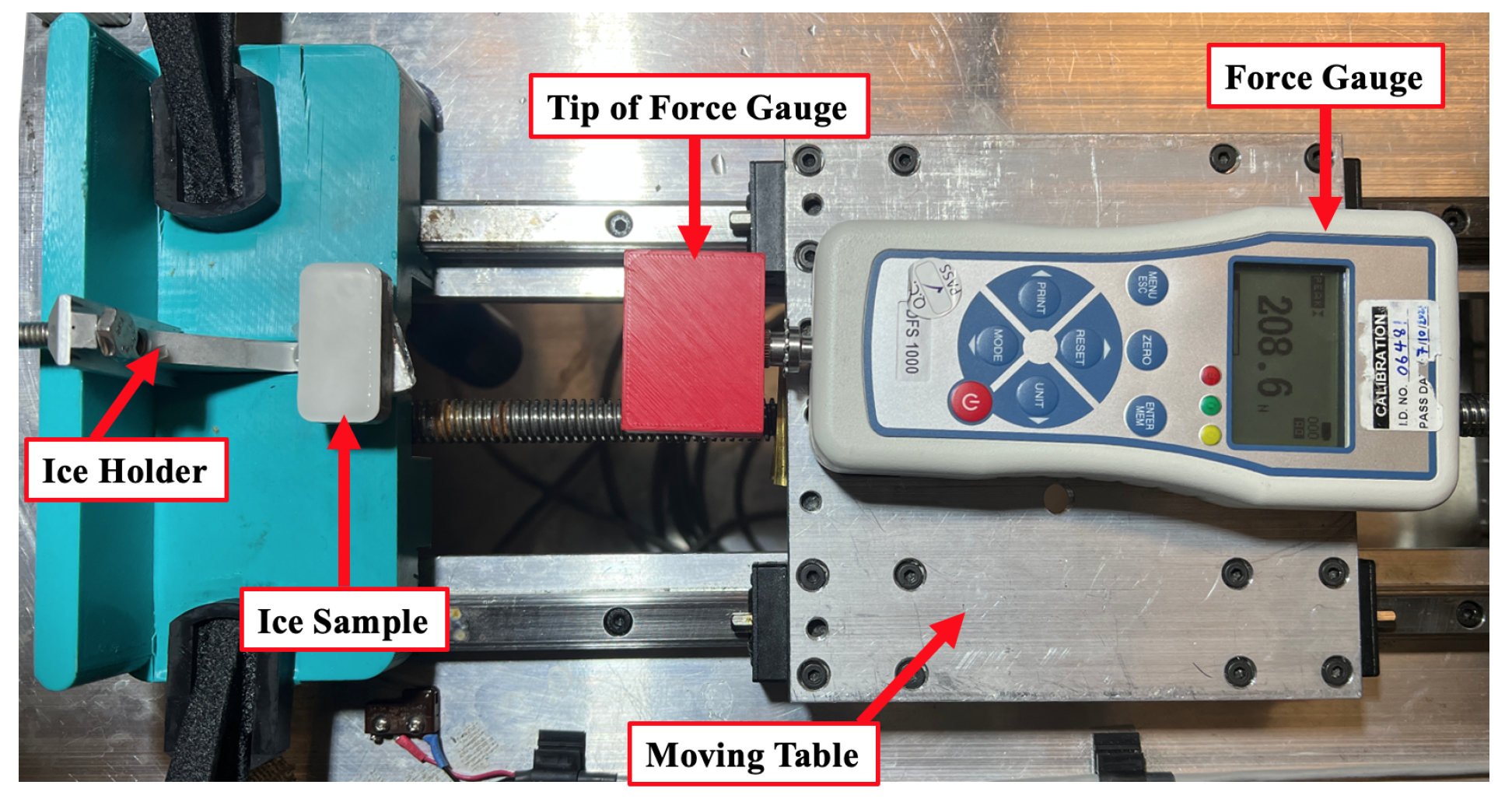

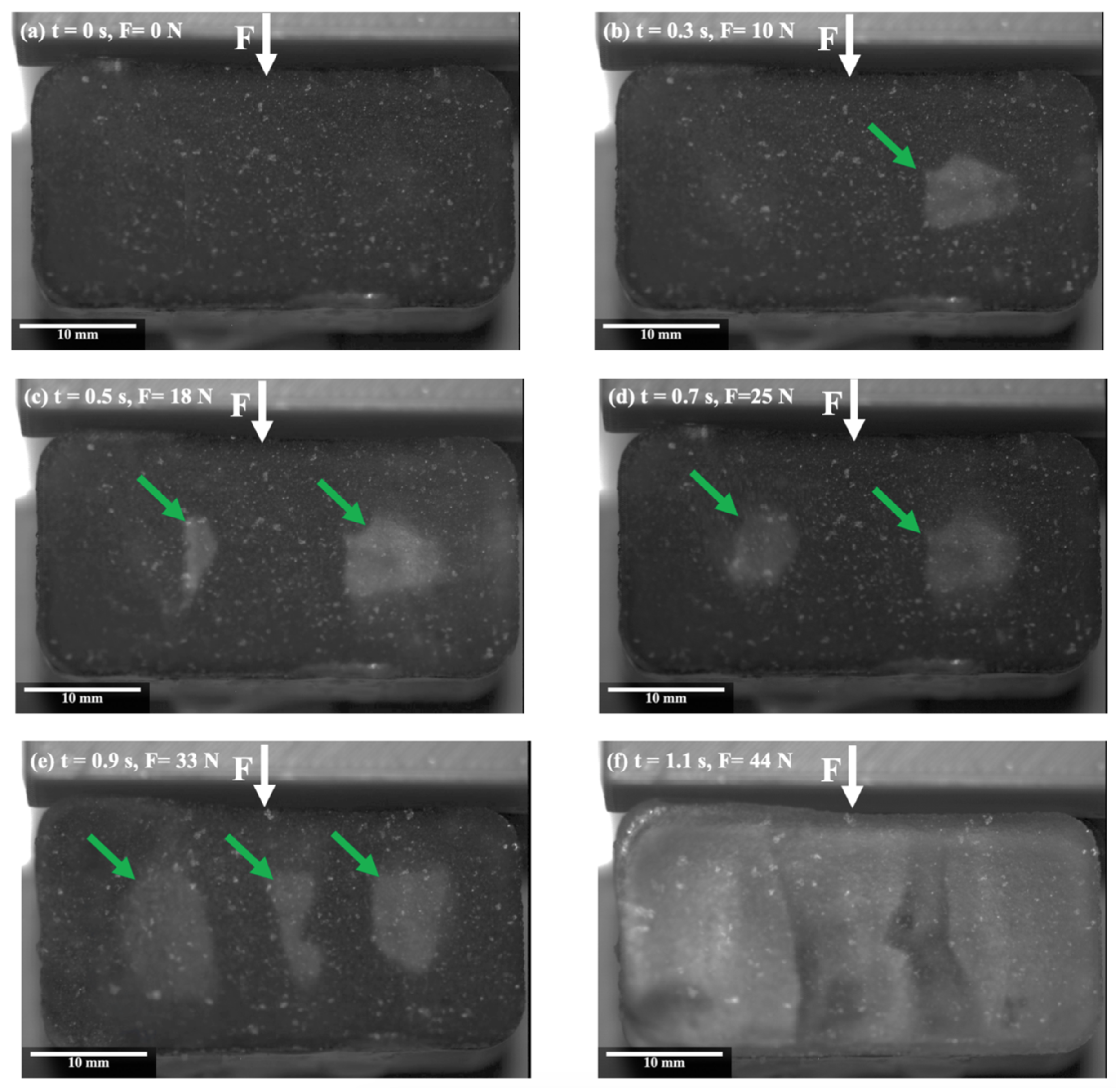

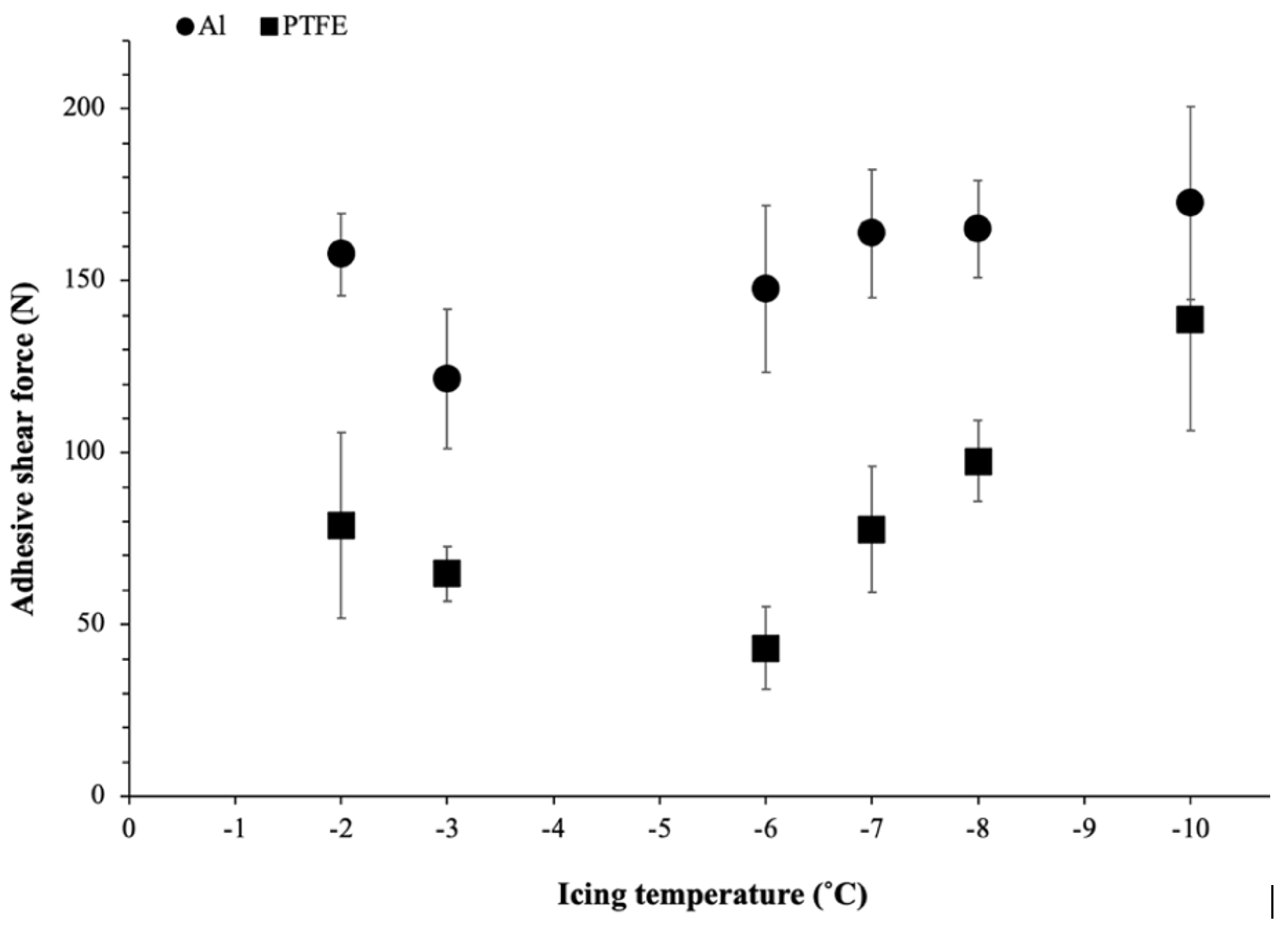

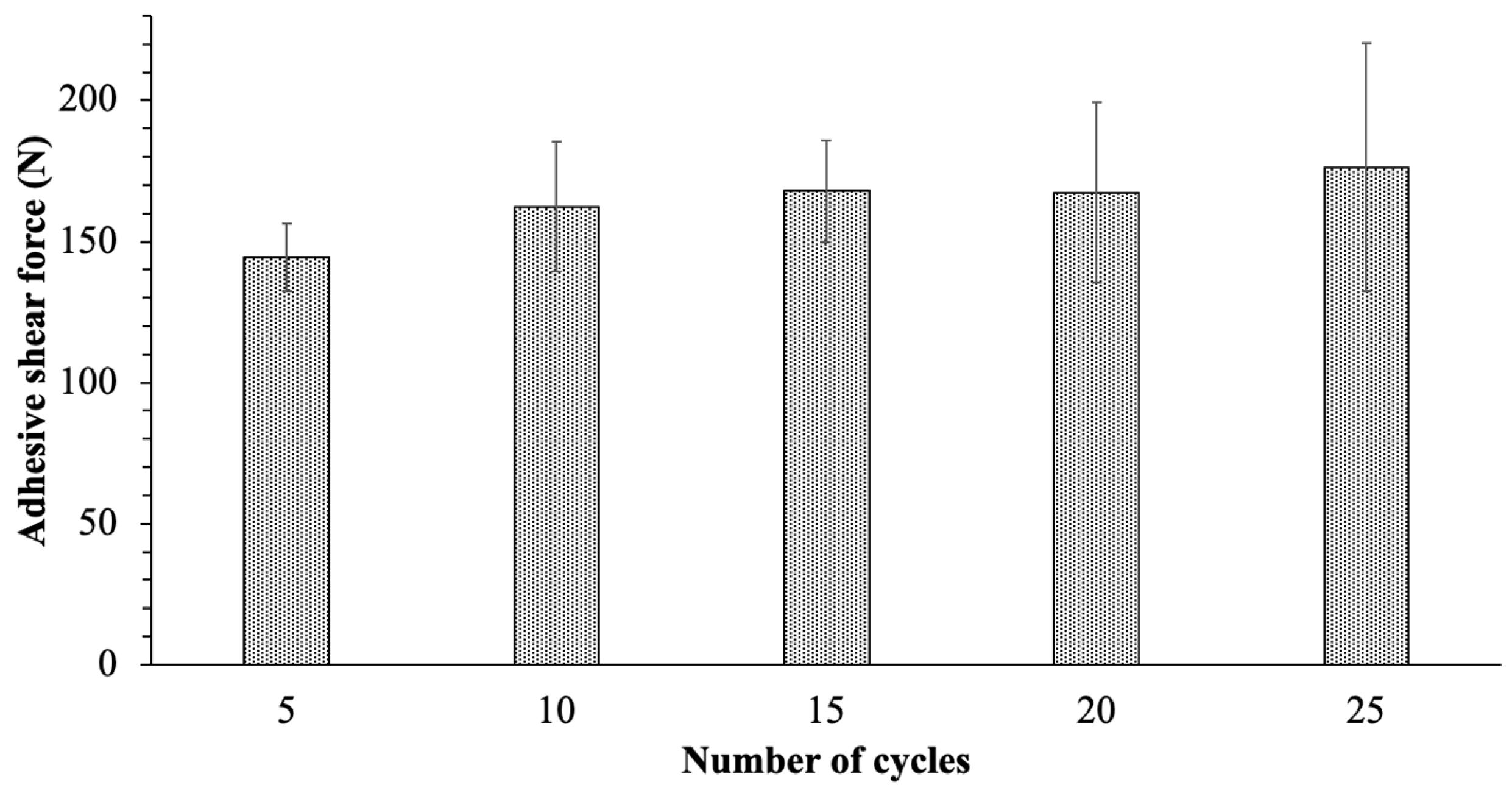

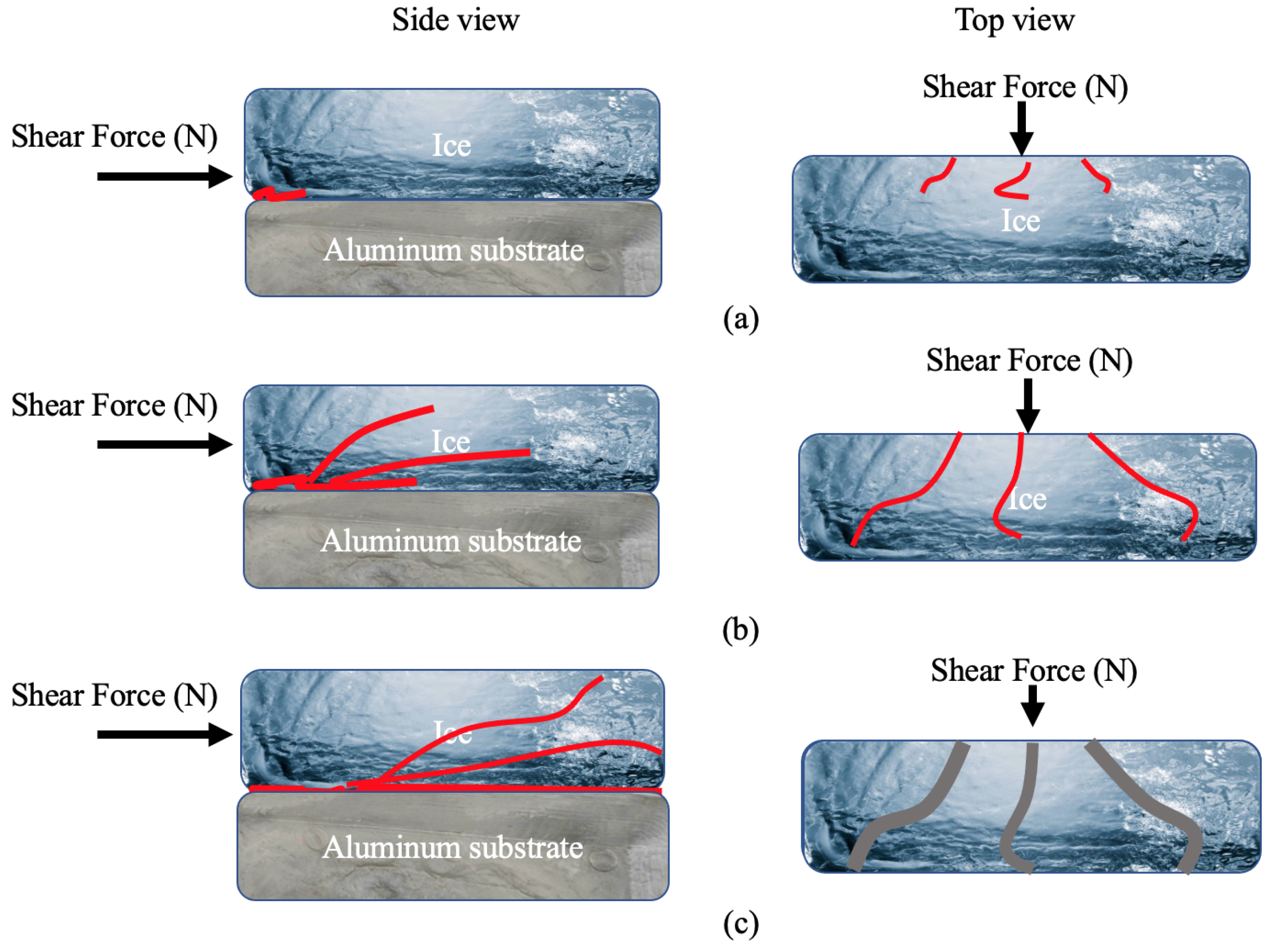

| Temperature (°C) | Airspeed (m/s) | MVD (µm) | LWC (gr/m3) | Ice Type |
|---|---|---|---|---|
| 0 to −3 | 45 ± 3 | 20 ± 3 | 0.2 ± 0.02 | Clear or Glaze |
| −3 to −6 | 45 ± 3 | 20 ± 3 | 0.2 ± 0.02 | Mixed |
| −7 to −10 | 45 ± 3 | 20 ± 3 | 0.2 ± 0.02 | Rime-mixed |
| Pull-Off Force (µN) | WCA (°) | CAH (°) | |
|---|---|---|---|
| Aluminium | 0.182 ± 0.8 | 62 ± 5 | 83 ± 4 |
| PTFE | 0.105 ± 0.01 | 94 ± 2 | 48 ± 6 |
| Pull-Off Force (µN) | WCA (°) | CAH (°) | |
|---|---|---|---|
| Aluminum | 0.182 ± 0.8 | 62 ± 5 | 83 ± 4 |
| PTFE | 0.105 ± 0.01 | 94 ± 2 | 48 ± 6 |
| (µm) | (µm) | |||
|---|---|---|---|---|
| PTFE | 1 ± 0.3 | 1.3 ± 0.4 | 0.05 | 4.12 |
| Al | 1 ± 0.4 | 1.6 ± 0.35 | 0.85 | 7.04 |
Disclaimer/Publisher’s Note: The statements, opinions and data contained in all publications are solely those of the individual author(s) and contributor(s) and not of MDPI and/or the editor(s). MDPI and/or the editor(s) disclaim responsibility for any injury to people or property resulting from any ideas, methods, instructions or products referred to in the content. |
© 2023 by the authors. Licensee MDPI, Basel, Switzerland. This article is an open access article distributed under the terms and conditions of the Creative Commons Attribution (CC BY) license (https://creativecommons.org/licenses/by/4.0/).
Share and Cite
Farahani, E.; Liberati, A.C.; Moreau, C.; Dolatabadi, A.; Stoyanov, P. Comparative Evaluation of the Shear Adhesion Strength of Ice on PTFE Solid Lubricant. Lubricants 2023, 11, 105. https://doi.org/10.3390/lubricants11030105
Farahani E, Liberati AC, Moreau C, Dolatabadi A, Stoyanov P. Comparative Evaluation of the Shear Adhesion Strength of Ice on PTFE Solid Lubricant. Lubricants. 2023; 11(3):105. https://doi.org/10.3390/lubricants11030105
Chicago/Turabian StyleFarahani, Emad, Andre C. Liberati, Christian Moreau, Ali Dolatabadi, and Pantcho Stoyanov. 2023. "Comparative Evaluation of the Shear Adhesion Strength of Ice on PTFE Solid Lubricant" Lubricants 11, no. 3: 105. https://doi.org/10.3390/lubricants11030105
APA StyleFarahani, E., Liberati, A. C., Moreau, C., Dolatabadi, A., & Stoyanov, P. (2023). Comparative Evaluation of the Shear Adhesion Strength of Ice on PTFE Solid Lubricant. Lubricants, 11(3), 105. https://doi.org/10.3390/lubricants11030105








